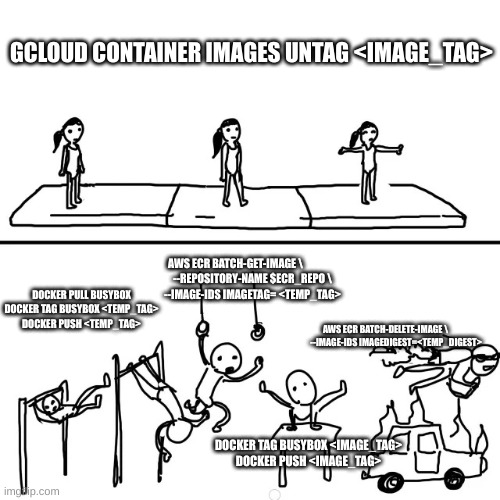I had to go full Rube Goldberg to clean up old image tags from closed PRs, while still leaving deletion of untagged image to the ECR repo's own lifecycle policy. Never go full Rube Goldberg:
name: ECR Retention Policy
on:
pull_request:
types:
- closed
workflow_call:
workflow_dispatch:
jobs:
clean-unused-ecr:
name: Delete unused container images
runs-on: runs-on,runner=2cpu-linux-x64,run-id=${{ github.run_id }},image=ecr_login_image
steps:
- name: Configure AWS credentials
uses: aws-actions/configure-aws-credentials@v4
with:
aws-region: ${{ env.RUNS_ON_AWS_REGION }}
- name: AWS ECR Login
id: login-ecr
uses: aws-actions/amazon-ecr-login@v2
- name: AWS ECR Info
shell: bash
run: |
echo "ECR_REGISTRY=${{ steps.login-ecr.outputs.registry }}" >> $GITHUB_ENV
echo "ECR_REPO=$(basename ${{ github.repository }})" >> $GITHUB_ENV
- name: Docker meta
id: docker_meta
uses: docker/metadata-action@v5
with:
images: ${{ env.ECR_REGISTRY }}/${{ env.ECR_REPO }}
flavor: suffix=-
tags: type=raw,value=${{ github.head_ref || github.ref_name }}
# NOTE: This is convoluted because AWS ECR has no simple way to untag image without deletion
# given we want to leave deletion of untagged image to the ECR repo's own lifecycle policy
# https://stackoverflow.com/questions/70065254/remove-ecr-image-tag-despite-imagereferencedbymanifestlist-error
# https://github.com/aws/containers-roadmap/issues/1567
- name: AWS ECR Cleanup
shell: bash
run: |
REPO_EXISTS=$(aws ecr describe-repositories --repository-names $ECR_REPO 2>&1 || true)
if echo "${REPO_EXISTS}" | grep -q 'RepositoryNotFoundException'; then
echo "Repository not found, skipping cleanup."
exit 0
fi
IMAGE_TAGS=$(aws ecr list-images --repository-name $ECR_REPO --query 'imageIds[*].imageTag' --output text)
docker pull busybox
docker tag busybox $ECR_REGISTRY/$ECR_REPO:_
docker push $ECR_REGISTRY/$ECR_REPO:_
TEMP_IMAGE=$(
aws ecr batch-get-image \
--repository-name $ECR_REPO \
--image-ids imageTag=_ )
TEMP_MANIFEST=$(echo $TEMP_IMAGE | jq -r '.images[].imageManifest')
TEMP_DIGEST=$(echo $TEMP_IMAGE | jq -r '.images[].imageId.imageDigest')
TAG_PREFIX=$(echo ${{ fromJSON(steps.docker_meta.outputs.json).tags[0] }} | cut -d: -f2)
for TAG in $IMAGE_TAGS
do
if [[ $TAG == $TAG_PREFIX* ]]; then
docker tag busybox $ECR_REGISTRY/$ECR_REPO:$TAG
docker push $ECR_REGISTRY/$ECR_REPO:$TAG
echo "Untaged image $TAG"
fi
done
# Delete the temporary image by digest
aws ecr batch-delete-image \
--repository-name $ECR_REPO \
--image-ids imageDigest=$TEMP_DIGEST

Tagging an image is simply associating a string value to an image pushed to a container registry, as a human readable identifier. Unlike an image ID or image digest sha, an image tag is only loosely associated, and can be remapped later to another image in the same registry repo, e.g
latest. Untagging is simply removing the tag from the registry, but not necessarily the associated image itself.